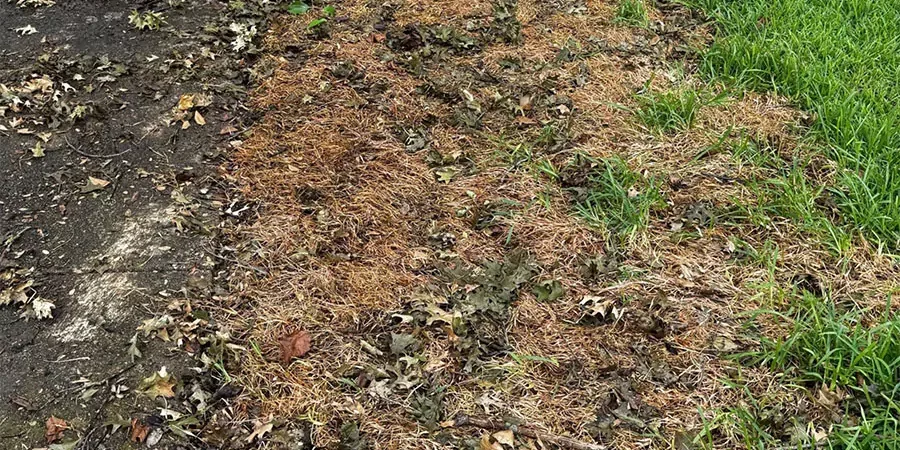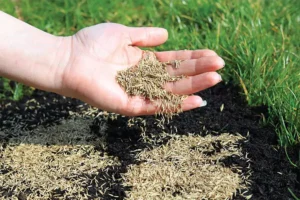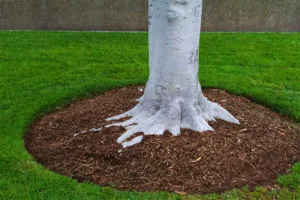After a storm rolls through Omaha, your lawn can look more like a swampy battlefield than the neat, green space you’re used to. Fallen branches, standing water, ripped-up grass—it’s enough to make even the most seasoned homeowner sigh.
But hold up! Before you grab a rake and start hauling debris, there are a few post-storm cleanup mistakes that a seasoned lawn maintenance company like Shurlawn & Landscape sees all too often—and they can end up doing more harm than good. We’ve been helping Omaha lawns bounce back from storm damage for years, and trust us: a little know-how goes a long way.
In this post, let’s help you know the most common missteps folks make during post-storm lawn care—and how to avoid them, so your yard can recover faster, greener, and stronger than ever.
Did that last storm leave your yard looking like a mess?
That’s why we’re here to help you avoid the most common lawn care mistakes after a storm. Whether it’s improper mowing, skipping aeration, or using the wrong fertilizer, these errors can set your lawn back weeks—or even months.
With our expert lawn care tips and a clear post-storm plan, your lawn in Omaha, NE, can recover quickly and beautifully. We’ll help you manage lawn maintenance, weed control, overseeding, fertilization, and even trimming without damaging your turf. For a complete seasonal approach, don’t miss our detailed resource on year-round lawn care strategies, packed with tips to keep your grass healthy no matter the weather.
And if DIY sounds like too much, our professional lawn service in Omaha is always here to lend a hand, with great service you can count on.
Let’s get your Omaha lawn care routine storm-ready and mistake-free. Read on to discover the biggest lawn care missteps to avoid—and if you need help, trust the local pros at Shurlawn & Landscape, your go-to lawn care company serving Omaha, Bellevue, and beyond. We’re here to make your lawn look its best, one storm at a time.
Immediate post-storm lawn assessment
After a big summer storm rolls through Omaha, your lawn can look rough. At Shurlawn & Landscape, we see this all the time.
What are the first steps homeowners should take when assessing lawn damage after a summer storm in Omaha?
We always say: give your lawn a minute to dry out before walking on it.
Here are a few first steps we recommend:
- Walk around and check for puddles or soft, mushy spots.
- Pick up any big branches or sticks that have fallen.
- Clear away wet leaves before they sit too long.
- Look at your sprinkler system—any broken heads?
- Check if the soil looks like it washed away.
How can one identify signs of soil compaction or erosion caused by heavy rainfall?
When the soil gets packed too tightly from rain, your grass can’t grow well. That’s compaction. When will it wash away completely? That’s erosion.
Here’s what we look for:
- Water is sitting in one spot way too long.
- Thin patches of grass or bare spots.
- Hard ground you can’t push your finger into.
I remember a job in Ralston where the backyard had huge ruts from running water. We used aeration and overseeding to help it bounce back. The owner said, “I didn’t even know water could do that much damage.” That’s why professional lawn care matters.
What indicators suggest that grass has suffered from waterlogging or flooding?
Too much water means your grass can’t breathe. It kind of drowns. If your lawn is squishy days after the storm, it might be in trouble.
Look for:
- Yellowing or browning patches.
- A musty smell.
- Mushy roots or even fungus.
We had a call from a homeowner near Elkhorn whose lawn smelled like an old towel. Their sprinkler system kept running even after the storm, making it worse. Our team fixed the sprinkler repair and helped restore the beautiful green lawn they wanted.
How does storm debris, such as fallen branches and leaves, impact lawn health if not promptly removed?
Storm debris does more than make your yard look messy. Wet leaves block sunlight and trap moisture, which can lead to mold. Fallen limbs crush grass and keep it from growing back.
In Bellevue, one homeowner left tree limbs on their lawn for days. Underneath? Dead grass and bugs. When we cleaned it up and added fertilizer, the lawn slowly came back—but it took weeks.
So yes—cleanup matters a lot. That’s why our lawn care in Omaha includes debris removal, especially for residential and commercial clients.
After a heavy storm hit last fall, I noticed a lot of debris in my yard on Pine Street in Omaha—fallen branches, wet leaves, and scattered twigs. At first, I didn’t think much of it, but I quickly realized that leaving the debris there wasn’t just an eyesore—it was damaging my lawn.
The wet leaves were blocking sunlight and trapping moisture, which led to mold growth. The tree limbs that had fallen were heavy, and they were crushing the grass, preventing it from growing back properly.
By the time I reached out to Shurlawn & Landscape, the damage was done, and under the debris, my grass was dead, and there were even bugs everywhere. Shurlawn came in, cleaned up the debris, and added a layer of fertilizer.
It took a little time, but with their help, my lawn started coming back to life. It was a slow recovery, but it was worth it in the end. – Tom, Pine Street, Omaha, NE
When should homeowners consider professional lawn care services for post-storm cleanup?
You should call for Omaha lawn care services if:
- Your grass isn’t drying out.
- You see bare spots and don’t know how to fix them.
- Your sprinkler system got damaged.
- Branches tore up your outdoor space.
- You’re just feeling overwhelmed.
Common mistakes to avoid during cleanup
Why is it detrimental to mow the lawn immediately after a storm without proper assessment?
We’ve seen this a lot in the Omaha area—a big storm rolls through, and the next day, someone grabs their mower. The problem? Wet soil plus a mowing service means ruts and torn-up grass.
In Bellevue, one homeowner called us after their mower left deep tracks. We had to fix it with aeration and overseeding. If the ground is too soft, wait a few days.
How can overwatering or improper irrigation exacerbate post-storm lawn issues?
When storms dump a bunch of rain, your sprinkler system doesn’t need to run. But some systems in Omaha lawns stay on anyway. That’s double the water and leads to puddles, root rot, and fungus.
We fixed this for a residential property in west Omaha—just adjusted the controller and did some light trimming around soggy areas. Good irrigation is part of smart lawn maintenance.
What are the risks of applying fertilizer too soon after storm damage?
Adding fertilizer too early can hurt your lawn. After a storm, the grass is weak and soaked. We treated a yard in NE Omaha where someone dumped fertilizer too fast—it burned the grass, and we had to reapply a full lawn care program, including weed control and aeration. Wait until the soil dries and the grass starts bouncing back before you feed it.
How does neglecting to aerate compacted soil affect grass recovery?
Storms pack the soil down, especially in areas with foot traffic or where the landscape slopes. That makes it hard for water, air, and nutrients to get to the roots.
We always recommend aeration after big storms, especially for commercial lawn care properties that get lots of use. Lawn care in Omaha isn’t just about cutting; it’s about helping the lawn grow back strong.
What are the consequences of ignoring thatch buildup following a storm?
After a storm, your lawn may look fine on top, but underneath, thatch (a thick layer of dead grass and debris) builds up. If you skip cleaning it, the grass can’t breathe or grow well.
In Bellevue, we handled a job where soggy thatch caused fungus to spread. Our lawn care service included dethatching, mowing, and fresh fertilization—now it’s a beautiful green lawn again.
Best practices for post-storm lawn recovery
What is the recommended timeline for resuming regular lawn care routines after a storm?
We usually wait about 48 hours after the last rainfall before we start mowing the grass again. If it’s still soggy, we hold off. For Omaha and surrounding areas, we try to get back on a normal lawn care schedule as soon as the soil dries up a bit. We check the sprinkler system, remove debris, and then mow.
If the weather looks dry, we might also add overseeding or fertilizer. Keeping a regular lawn care program helps keep things smooth, even after big storms.
How can aeration and overseeding aid in lawn recovery post-storm?
Heavy rain packs the soil tight. That’s why aeration is one of our go-to tools. It pokes holes in the ground so air, water, and roots can move again. Then we follow up with overseeding to help fill in any bare spots.
What role does proper mulching play in restoring soil health after heavy rains?
Mulch is great—but only if it’s done right. Too much mulch holds in too much water, and that can hurt your plants. In West Omaha, we cleaned up a spot where mulch was piled up like a wall.
It was keeping the roots too wet. We thinned it out, added better wood chips, and planted some new trees and shrubs. The area dried up, and everything started to grow again.
Good mulch keeps the soil safe and helps stop erosion, especially after summer storms.
How can homeowners prevent future storm damage through strategic landscaping?
We design yards so water flows away from your home, not into it. In Omaha and the surrounding areas, we use smart landscape plans that include rocks, slopes, and even rain gardens (without calling them that!). We also plant trees that block strong winds and protect your outdoor space.
We fixed up a property in Gretna where rainwater used to pool near the patio. With a new slope, better mulch, and small retaining walls, the area hasn’t flooded since.
What are the benefits of consulting with local Omaha lawn care professionals for post-storm maintenance?
We’ve lived and worked in the Omaha area for years. We know what summer storms do to lawns around here. Some things can wait, and some things can’t.
Whether you live in Bellevue, Ralston, or right in the heart of Omaha, our team provides lawn care services in Omaha, NE that fit the season and the situation.
Our services include:
- Lawn mowing
- Sprinkler repair
- Aeration
- Fertilization
- Weed control
- Snow removal services
- And more for both residential and commercial clients
After the summer storm rolled through our neighborhood on Maple Street in Omaha, I knew my lawn had taken a hit. The heavy rain left patches of soggy ground, and with the wind blowing, several branches had fallen, blocking some areas from sunlight.
I wasn’t sure where to start, and I didn’t want to risk making things worse by trying to fix it myself. That’s when I reached out to Shurlawn & Landscape, knowing they had years of experience with Omaha’s weather conditions and how it impacts lawns.
They quickly assessed the damage and explained how certain services, like aeration and fertilization, were crucial to helping the grass recover from the storm.
They also handled the sprinkler repair to ensure everything was properly watered. With their professional care, my lawn started bouncing back, and I didn’t have to worry about additional damage. Shurlawn’s local expertise and tailored services made all the difference in restoring my yard. – Rachel, Maple Street, Omaha, NE.
Frequently asked questions about common lawn care mistakes to avoid during post-storm cleanup in Omaha, NE
1. Is it okay to mow the lawn right after a big storm?
No. Mowing wet grass can damage your lawn and your mower. It’s best to wait until the ground dries up so you don’t leave ruts or rip up the turf.
2. Should I leave branches and leaves on the grass for a few days?
No. Storm debris blocks sunlight and traps moisture, which can lead to disease and dead patches. Clean it up quickly to keep your lawn healthy.
3. Can I turn my sprinkler system back on right away after a storm?
No. If your lawn is already soaked from rain, extra watering will just flood it. Wait until the soil dries out before using your irrigation system again.
4. Is skipping aeration after a storm a good idea?
No. Storms often compact the soil, making it hard for grass to grow. Aerating helps loosen the soil and gives your lawn room to breathe and heal.
5. Should I ignore bare patches or muddy spots caused by storm damage?
No. Leaving damaged spots alone can lead to weeds or poor growth. It’s better to reseed and feed the area so your lawn can recover faster.
Call Shurlawn today for expert post-storm cleanup and lawn care in Omaha, NE.
Cleaning up after a storm in Omaha isn’t just about picking up sticks. It’s about taking care of your lawn the right way—so it grows back healthy and strong. Skipping steps like aeration, overseeding, or waiting too long to mow can lead to weak grass or bare spots.
If you live in Omaha or the surrounding area, it helps to call in a professional lawn care team like Shurlawn & Landscape. We offer comprehensive lawn care services, including lawn mowing, sprinkler repair, fertilization, weed control, and even snow removal services when winter rolls around.
If you’re in Bellevue, West Omaha, or anywhere in the Omaha metro area, we’re here to help with all your lawn care needs for residential and commercial properties. Your outdoor space deserves the best lawn care around, and we’re proud to be one of the top lawn care companies in Omaha. Call Shurlawn & Landscape today at 402-572-0710!




